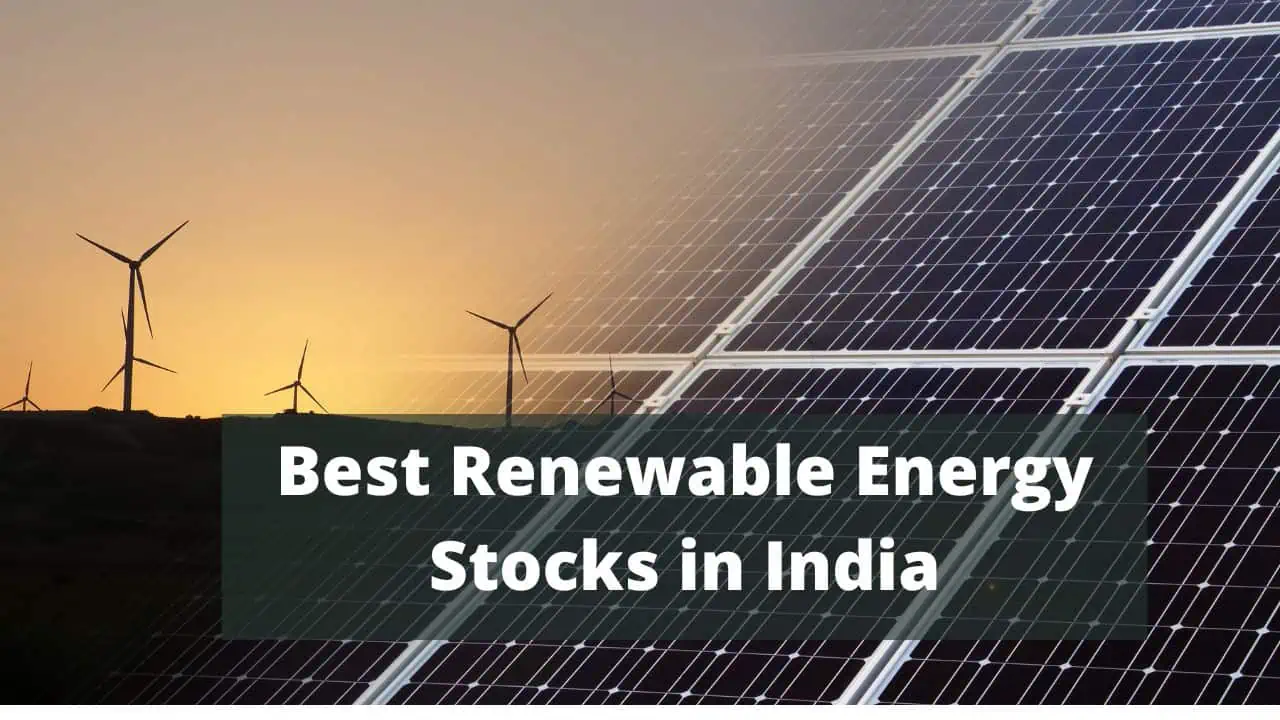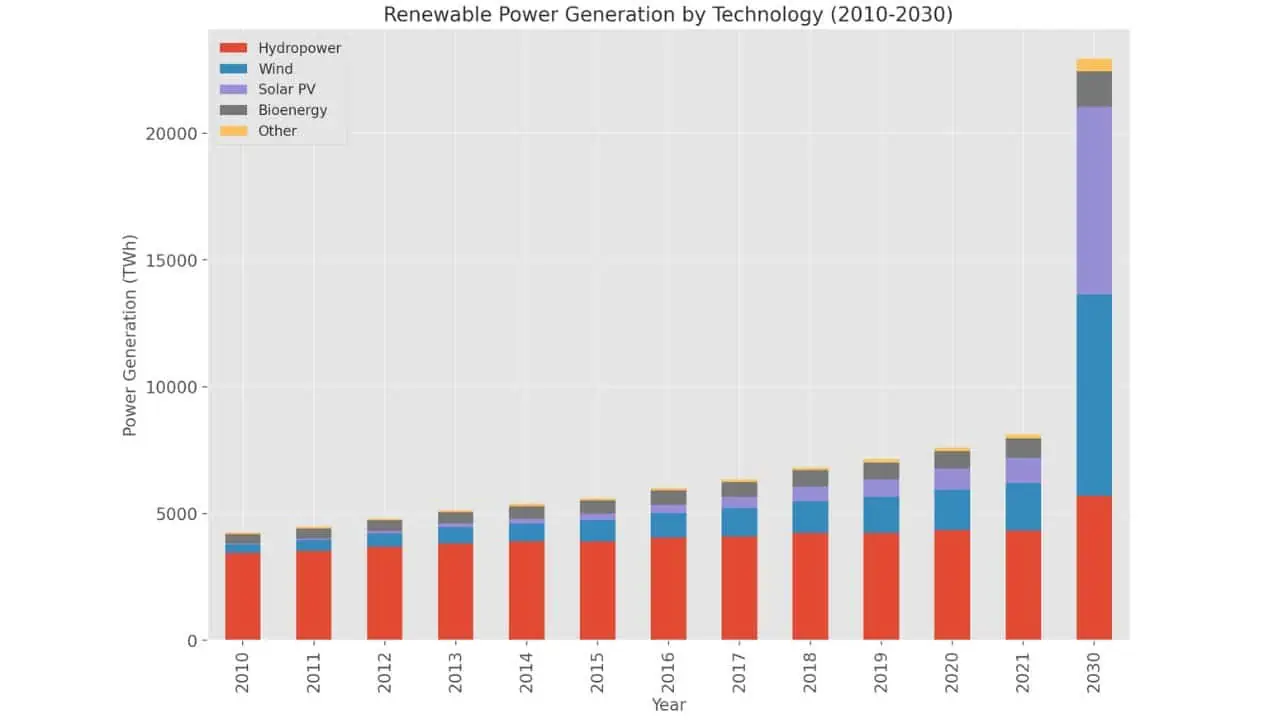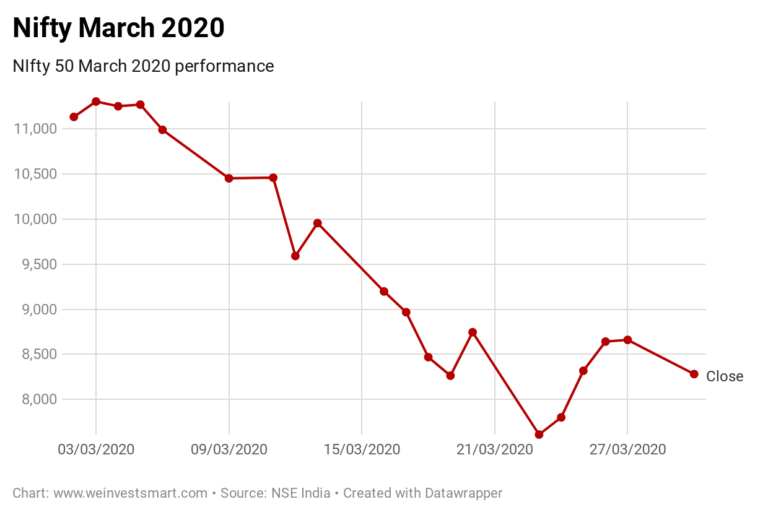Top 17 Best Renewable Energy Stocks in India: Solar, Wind, Hydro Power, and Sector Analysis
As the world pivots towards a more sustainable future, the renewable energy sector is gaining unprecedented momentum. This shift is particularly noticeable in India, a country that stands as the third-largest consumer and producer of renewable energy globally.

This article will delve into the best renewable energy stocks in India, offering insights into companies that are not only contributing to a greener future but also providing promising returns for investors.
With ambitious targets set for 2030 and a rapidly expanding renewable energy infrastructure, India’s green energy sector is ripe with investment opportunities.
Consider reading: Best EV Stocks in India
Let’s start by understanding what is happening in the Renewable Energy Business sector in India.
Page Contents
List of Best Renewable Energy Stocks in India
| Company | CMP (Rs) | Price to Earning | Price to Book | Debt to Equity | RoCE | Dividend Yield |
|---|---|---|---|---|---|---|
| INDIAN ENERGY EXCHANGE | 125.5 | 38.2 | 14.0 | 0.0 | 58.9% | 1.6% |
| INSOLATION ENERGY | 136.9 | -ve | 6.5 | 1.4 | 38.1% | 0.0% |
| SHIGAN QUANTUM | 71.3 | -ve | 2.3 | 0.4 | 30.8% | 0.0% |
| BOROSIL RENEWABLES | 495.8 | 91.6 | 7.4 | 0.2 | 24.1% | 0.0% |
| GAIL | 110.5 | 17.8 | 1.2 | 0.1 | 22.5% | 6.1% |
| IOC | 99.3 | 12.9 | 1.0 | 0.9 | 21.0% | 8.5% |
| L&T | 2,448.5 | 27.3 | 3.9 | 1.5 | 16.7% | 0.9% |
| TATA POWER | 227.9 | 119.3 | 2.5 | 1.7 | 16.5% | 0.9% |
| ADANI GREEN ENERGY | 950.9 | 164.8 | 25.6 | 9.2 | 8.7% | 0.0% |
| WEBSOL ENERGY | 86.7 | -ve | 1.8 | 0.2 | 8.7% | 0.0% |
| RELIANCE IND. | 2,635.5 | 24.1 | 2.2 | 0.4 | 10.2% | 0.3% |
| JSW ENERGY | 306.7 | 34.5 | 2.7 | 1.3 | 7.4% | 0.7% |
| OLECTRA GREENTECH | 1,231.4 | 157.3 | 12.0 | 0.1 | 7.4% | 0.0% |
| NTPC | 192.6 | 11.1 | 1.3 | 1.5 | 9.9% | 3.6% |
| INOX GREEN ENERGY | 57.6 | -ve | 1.5 | 1.1 | 4.4% | 0.0% |
| INOX WIND | 170.8 | -ve | 3.2 | 0.9 | -14.0% | 0.0% |
| STERLING AND WILSON SOLAR | 287.0 | -ve | -ve | -8.7 | -219.6% | 0.0% |
Renewable Energy Business in India
Here are some key data points on Renewable Energy Business in India:
- Renewable Energy Capacity: India is the world’s 3rd largest consumer of electricity and the 3rd largest renewable energy producer. As of 2023, India’s installed renewable energy capacity has reached 119.1 GW, up from 94.4 GW in 2021. The country has set a goal of 500 GW of renewable energy capacity by 2030.
- Solar Energy: As of September 2020, 89.22 GW of solar energy is operational, with projects of 48.21 GW at various stages of implementation and projects of 25.64 GW capacity under various stages of bidding. India is home to 3 of the world’s top 5 largest solar parks.
- Wind Power: India has a strong manufacturing base for wind power with 20 manufacturers of 53 different wind turbine models.
- Renewable Energy Attractiveness: Ernst & Young’s 2021 Renewable Energy Country Attractiveness Index (RECAI) ranked India 3rd behind the USA and China.
- Future Targets: The government has announced that no new coal-based capacity addition is required beyond the 50 GW under different stages of construction likely to come online between 2017 and 2022. The target for renewable energy capacity is set at 175 GW by 2022 and 500 GW by 2030.
- International Solar Alliance: India initiated the International Solar Alliance (ISA), an alliance of 121 countries. India was the world’s first country to set up a Ministry of non-conventional energy Resources (Ministry of New and Renewable Energy (MNRE)) in the early 1980s.
- Bioenergy: India has set a target to produce 15 million tons of biogas/bio-CNG by installing 5,000 large-scale commercial-type biogas plants.
- Waste to Energy: Every year, about 55 million tonnes of municipal solid waste (MSW) and 38 billion liters of sewage are generated in the urban areas of India. There are several companies in the waste-to-energy sector in India.
- FDI Initiative by Govt of India: FDI of up to 100% is allowed in the renewable energy industry under the automatic route, with no prior government approval needed.
- Indian Govt Schemes: The government has introduced various policies and schemes to promote renewable energy, such as the Production Linked Incentive (PLI) Scheme, National Solar Mission, National Wind-Solar Hybrid Policy, etc.
Now let’s look at the Best Renewable Energy Stocks in India which are ready to ride the Renewal Energy initiatives.
Consider reading: Top 10 Pharma Companies in India
Latest Happenings Renewable Energy Business Sector Globally
Before we finish the article, it’s very important to understand what is happening in Renewable Energy Business Sector Globally.

Source: IEA.Org
Here is a quick summary of developments in the renewable energy space:
- Role of Renewables: Renewables are crucial in clean energy transitions and in keeping the rise in average global temperatures below 1.5°C. The year 2022 was a record year for renewable capacity additions, with an expected total of about 340 GW. Key policies like REPowerEU and the US Inflation Reduction Act are expected to further accelerate renewable electricity deployment.
- Current State and Future Needs: The renewable share of generation needs to increase from almost 29% in 2021 to more than 60% by 2030 to reach Net Zero Emissions by 2050 Scenario. This requires an average annual increase of over 12% during 2022-2030, twice the average of 2019-2021. In 2021, renewable electricity generation rose by almost 7%, with wind and solar PV technologies accounting for almost 90% of this growth.
- Technology Deployment: Wind and solar PV were the main contributors to the record increase in renewable electricity generation in 2021. However, hydropower generation decreased for the first time in 20 years due to droughts in several regions. The deployment of all renewable technologies needs to increase significantly to meet the Net Zero Scenario.
- Policy Changes: Several important policy changes were implemented in 2021-2022, including China’s ambitious target of 33% of electricity generation from renewables by 2025, the US’s Inflation Reduction Act, and the European Commission’s proposal to increase the bloc’s renewable energy target for 2030 from 32% to 40%.
- Recommendations for Policy Makers: The report suggests ensuring renewable energy policy stability and predictability, shifting policy to competitive auctions, adjusting policy design to integrate variable renewables, addressing technology-specific challenges, and facilitating permitting for new projects and modernization.
- Private Sector Strategies: Companies are increasingly signing corporate power purchase agreements to purchase clean electricity directly from producers. This ensures the use of green technologies and hedges the price. The capacity contracted through these agreements rose to almost 25 GW in 2020.
Indian Energy Exchange
Overview of the Indian Energy Exchange:
- Indian Energy Exchange Limited (IEX) is India’s premier energy marketplace, providing a nationwide automated trading platform for the physical delivery of electricity, renewables, and certificates.
- It was established in 2008 and is approved and regulated by the Central Electricity Regulatory Commission (CERC).
- It is headquartered in New Delhi, India, and is a publicly listed company with NSE and BSE since October 2017.
- IEX holds a commanding market share of 94.2% across various segments, with an impressive 99.9% market share specifically in the DAM (Day-Ahead Market) and RTM (Real-Time Market).
- In India, there were two prominent energy exchanges, IEX and PXIL, with IEX enjoying the majority of the market share. However, a third power exchange called HPX entered the scene as the newest player. HPX was launched on July 6, 2022, and is promoted by BSE, PTC India, and ICICI Bank.
- It has a robust ecosystem of over 7,300 participants located across 29 States and 5 Union Territories comprising distribution utilities, conventional generators, renewable generators, obligated entities, and commercial and industrial consumers.
- It also has a strong base of cross-border electricity trade with neighboring countries such as Nepal, Bhutan, and Bangladesh.
- It has a total income of Rs. 445.4 crore (US$ 56.8 million) in FY22.
How Indian Energy Exchange Benefits from the Renewable Energy Business
- IEX benefits from the increasing demand for renewable energy in India and abroad, which is more environment-friendly and cost-effective than conventional fuels.
- IEX also benefits from its transparent, neutral, demutualized, and automated platform, which enables efficient price discovery and counter-party risk management for participants in the electricity market.
- IEX leverages its state-of-the-art technology, customer-centric approach, and innovation to provide high-quality and reliable energy solutions to its customers.
Who are their main competitors in the renewable energy business
Some of the main competitors of IEX in the renewable energy business are:
| Company | Products | Services |
|---|---|---|
| Power Exchange India Limited (PXIL) | Electricity, renewables, certificates | Trading platform |
| GreenX | Renewables | Trading platform |
| Pranurja Solutions Limited | Electricity, renewables | Trading platform |
| Power Ledger | Renewables | Blockchain-based platform |
The Indian Energy Exchange stock has seen huge interest from retail stakeholders in 2021.
The stock went up to Rs 300 but has been falling consistently since 2022. Currently, it’s trading near Rs 125.
Looking at the ROCE figures of IEX, it is one of the best renewable energy stocks in India.
Consider reading: IEX Share Price Target
Insolation Energy
Overview of Insolation Energy:
- Insolation Energy is a leading solar manufacturing company in India dedicated to working towards technology upgradation to improve the efficiency of its PV modules and collaborating with global leaders to bring out the best technology in the solar industry for a greener, sustainable, and better solar future.
- It was incorporated in 2015 and is a part of the Insolation Group of Companies, one of India’s leading business conglomerates.
- It has set up a state-of-the-art fully automatic solar PV module manufacturing plant at Jaipur, Rajasthan with a capacity of 100 MW per annum.
- It also provides solar power pack solutions, including solar tubular/Li-ion batteries and solar PCU, for home office and home education segments.
- It has a total income of Rs. 1,042.67 crore (US$ 132.9 million) in FY22.
How Insolation Energy Benefits from the Renewable Energy Business
- Insolation Energy benefits from the increasing demand for solar power in India and abroad, which is expected to reach 280 GW by 2030.
- Insolation Energy also benefits from its competitive pricing, quality products, and customer service, which enable it to cater to both domestic and international markets.
- Insolation Energy leverages its research and development capabilities to innovate and improve its solar cell and module efficiency and performance.
Who are Insolation Energy’s Main Competitors
Some of the main competitors of Insolation Energy in the solar cell and module manufacturing market are:
| Company | Capacity | Products |
|---|---|---|
| Tata Power Solar | 1.1 GW | Monocrystalline and polycrystalline solar cells and modules |
| Vikram Solar | 1.2 GW | Monocrystalline and polycrystalline solar cells and modules |
| Waaree Energies | 2 GW | Monocrystalline and polycrystalline solar cells and modules |
| Adani Solar | 2.5 GW | Monocrystalline and polycrystalline solar cells and modules |
Insolation Energy is one of the best Best Renewable Energy Stocks in India considering its return on capital employed.
Shigan Quantum
Overview of Shigan Quantum:
- Shigan Quantum Technologies Pvt. Ltd. (Shigan) is an alternative fuel system solution provider for automotive, locomotive, and stationary engine applications.
- It was established in 2007 and is a part of the Shigan Group of Companies, one of India’s leading business conglomerates.
- It provides solutions for CNG, LNG, LPG, hydrogen,, and electric vehicles, including gas injectors, engine control units, high-pressure regulators, filters, filling units, fire detection and suppression systems, electric water pumps, etc.
- It also provides turnkey solutions for dual fuel conversion of locomotives and electric three-wheelers.
- It has a total income of Rs. 1,042.67 crore (US$ 132.9 million) in FY22.
How Shigan Quantum Benefits from the Renewable Energy Business
- Shigan Quantum benefits from the increasing demand for alternative fuel systems in India and abroad, which are more environment-friendly and cost-effective than conventional fuels.
- Shigan Quantum also benefits from its strong parentage and brand recognition, which gives it access to a large customer base and a diversified portfolio of products and services.
- Shigan Quantum leverages its technical expertise, research and development capabilities, and operational excellence to provide high-quality and innovative solutions to its clients.
Who are Shigan Quantum’s Main Competitors
Some of the main competitors of Shigan Quantum in the alternative fuel system solutions market are:
| Company | Products | Services |
|---|---|---|
| Tomasetto Achille | CNG/LPG kits and components | Manufacturing and distribution |
| Lovato Gas | CNG/LPG kits and components | Manufacturing and distribution |
| Bosch | CNG/LPG kits and components | Manufacturing and distribution |
| Mahindra & Mahindra | Electric vehicles | Manufacturing and sales |
Borosil Renewables
Overview of Borosil Renewables:
- Borosil Renewables Limited is the first and only solar glass manufacturer in India, producing high-quality and high-efficiency solar glass for photovoltaic panels, flat plate collectors, and greenhouses.
- It was established in 2010 and is a part of the Borosil group, which is well-known for the brand “BOROSIL®” which manufactures a range of labware, scientific ware, and consumer ware products.
- It is headquartered in Mumbai, Maharashtra, and has a solar glass manufacturing plant in Bharuch, Gujarat with a capacity of 450 TPD (equivalent to solar glass for 2.8 GW of solar modules).
- It also acquired Interfloat Group, the largest solar glass manufacturer in Europe with a capacity of 300 TPD (equivalent to solar glass for 2 GW of solar modules) in 2021.
- It has a total income of Rs. 505.6 crore (US$ 64.4 million) in FY22.
How Borosil Renewables Benefits from the Renewable Energy Business
- Borosil Renewables benefits from the increasing demand for solar power in India and abroad, which is expected to reach 280 GW by 2030.
- Borosil Renewables also benefits from its competitive pricing, quality products, and customer service, which enable it to cater to both domestic and international markets.
- Borosil Renewables leverages its research and development capabilities to innovate and improve its solar glass efficiency and performance.
Who are Borosil Renewables’s Main Competitors
Some of the main competitors of Borosil Renewables in the solar glass manufacturing market are:
| Company | Capacity | Products |
|---|---|---|
| Xinyi Solar | 13 GW | Solar glass |
| Flat Glass Group | 8 GW | Solar glass |
| Almaden | 6 GW | Solar glass |
| Vidur Glass Industries | 1.5 GW | Solar glass |
GAIL
Overview of GAIL:
- GAIL (India) Limited (formerly known as Gas Authority of India Limited) is India’s leading natural gas company with diversified interests across the natural gas value chain of trading, transmission, LPG production & transmission, LNG re-gasification, petrochemicals, city gas, E&P, etc.
- It was established in 1984 and is headquartered in New Delhi, India.
- It is a Maharatna Company under the ownership of the Ministry of Petroleum and Natural Gas, Government of India.
- It owns and operates a network of over 13,700 km of natural gas pipelines, 7 LPG plants, 2 LNG terminals, and 5 petrochemical plants in India.
- It also has an overseas presence in Egypt, Myanmar, the USA, Singapore, and China.
- It has a total income of Rs. 56,569.20 crore (US$ 7.2 billion) in FY22.
How GAIL Benefits from the Renewable Energy Business
- GAIL benefits from the increasing demand for natural gas in India and abroad, which is a cleaner and cheaper alternative to conventional fuels.
- GAIL also benefits from its diversified business portfolio, which reduces its exposure to any single market or source of supply and enhances its operational flexibility and efficiency.
- GAIL leverages its technical expertise, research and development capabilities, and operational excellence to provide high-quality and reliable energy solutions to its customers.
Who are GAIL’s Main Competitors
Some of the main competitors of GAIL in the natural gas sector are:
| Company | Products | Services |
|---|---|---|
| Indraprastha Gas | CNG, PNG | City gas distribution |
| Petronet LNG | LNG | LNG import and re-gasification |
| Gujarat State Petronet | Natural gas | Natural gas transmission |
| Reliance Industries | Natural gas, LNG | Exploration & production |
IOC
Overview of IOC:
- IOC (Indian Oil Corporation Limited) is a Maharatna Company controlled by the Government of India that has business interests straddling the entire hydrocarbon value chain – from refining, pipeline transportation, and marketing of petroleum products to R&D, exploration & production, marketing of natural gas and petrochemicals.
- It was established in 1959 and is headquartered in New Delhi, India.
- It is the largest commercial oil company in India and the leading Indian company in Fortune’s ‘Global 500’ listing.
- It operates 11 refineries, 15,000 km of pipelines, 30,000 fuel stations, 13,000 LPG distributors, and 7 petrochemical plants in India.
- It also has an overseas presence in Sri Lanka, Mauritius, UAE, Singapore, and the USA.
- It has a total income of Rs. 4,98,929.34 crore (US$ 63.6 billion) in FY22.
How IOC Benefits from the Renewable Energy Business
- IOC benefits from the increasing demand for renewable energy in India and abroad, which is more environment-friendly and cost-effective than conventional fuels.
- IOC also benefits from its diversified fuel mix, which reduces its dependence on any single source of energy and enhances its operational flexibility and efficiency.
- IOC leverages its technical expertise, research and development capabilities, and operational excellence to provide high-quality and reliable energy solutions to its customers.
Who are IOC’s Main Competitors
Some of the main competitors of IOC in the oil and gas sector are:
| Company | Products | Services |
|---|---|---|
| BPCL | Petroleum products, natural gas | Refining, marketing, exploration |
| HPCL | Petroleum products, natural gas | Refining, marketing, exploration |
| Reliance Industries | Petroleum products, natural gas, petrochemicals | Refining, marketing, exploration |
| ONGC | Crude oil, natural gas | Exploration & production |
L&T
Overview of L&T:
- L&T (Larsen & Toubro Limited) is an Indian multinational conglomerate company, with business interests in engineering, construction, manufacturing, technology, information technology, and financial services.
- It was founded in 1946 by two Danish engineers, Henning Holck-Larsen and Søren Kristian Toubro, who started a small workshop to undertake engineering jobs in Bombay.
- It is headquartered in Mumbai, Maharashtra, and has operations in over 50 countries across five continents.
- It is among the world’s top contractors and India’s largest construction company, with expertise in various sectors such as buildings & factories, transport infrastructure, heavy civil infrastructure, smart world & communication, water & renewable energy, and power transmission & distribution.
- It also has a strong presence in the defense, shipbuilding, hydrocarbon, power, minerals & metals, and heavy engineering sectors.
- It has a total income of Rs. 1,35,979 crore (US$ 17.3 billion) in FY22.
How L&T Benefits from the Renewable Energy Business
- L&T benefits from the increasing demand for renewable energy in India and abroad, which is more environment-friendly and cost-effective than conventional fuels.
- L&T also benefits from its diversified business portfolio, which reduces its exposure to any single market or source of supply and enhances its operational flexibility and efficiency.
- L&T leverages its technical expertise, project management capabilities, and operational excellence to provide high-quality and reliable energy solutions to its customers.
Who are L&T’s Main Competitors
Some of the main competitors of L&T in the engineering and construction sector are:
| Company | Products | Services |
|---|---|---|
| Tata Projects | Infrastructure projects | Engineering, procurement and construction |
| Adani Group | Infrastructure projects | Engineering, procurement and construction |
| Hindustan Construction Company | Infrastructure projects | Engineering, procurement and construction |
| Shapoorji Pallonji Group | Infrastructure projects | Engineering, procurement and construction |
Tata Power
Overview of Tata Power:
- Tata Power Limited is one of India’s largest integrated power companies, with a presence across the entire power value chain of conventional and renewable energy, power services, and next-generation customer solutions including solar rooftop, EV charging stations, and home automation.
- It was established in 1911 as Tata Electric and is a part of the Tata Group, one of India’s leading business conglomerates.
- It is headquartered in Mumbai, Maharashtra, and has operations in over 20 countries across five continents¹³.
- It operates 14,110 MW of generation capacity, of which 37% comes from clean and green sources such as solar, wind, hydro, and waste gas.
- It also owns and operates India’s largest transmission network with over 12,000 circuit km of lines.
- It has a total income of Rs. 28,948 crore (US$ 3.7 billion) in FY22.
How Tata Power Benefits from the Renewable Energy Business
- Tata Power benefits from the increasing demand for renewable energy in India and abroad, which is more environment-friendly and cost-effective than conventional fuels.
- Tata Power also benefits from its diversified business portfolio, which reduces its exposure to any single market or source of supply and enhances its operational flexibility and efficiency.
- Tata Power leverages its technical expertise, research and development capabilities, and operational excellence to provide high-quality and reliable energy solutions to its customers.
Who are Tata Power’s Main Competitors
Some of the main competitors of Tata Power in the renewable energy business are:
| Company | Capacity | Sources |
|---|---|---|
| Adani Green Energy | 14.8 GW | Solar, wind |
| ReNew Power | 10 GW | Solar, wind |
| JSW Energy | 4.6 GW | Coal, hydro |
| NTPC | 7.1 GW | Coal, gas, hydro, solar, wind |
Because of its reputation in Tata Group and the initiatives taken by Tata Group Chairman N. Chandra, The Tata Power Stock is one of the Best Renewable Energy Stocks in India.
Consider reading: Tata Power Share Price Target
Adani Green Energy
Overview of Adani Green Energy:
- Adani Green Energy Limited (AGEL) is one of the largest renewable companies in India, with a current project portfolio of 20,434 MW.
- It was established in 2015 and is a part of the Adani Group, one of India’s leading business conglomerates.
- It is headquartered in Ahmedabad, Gujarat, and has operations in several Indian states and overseas markets.
- It operates various solar and wind power projects, including the Kamuthi Solar Power Project, one of the largest solar photovoltaic plants in the world.
- It also operates a green hydrogen business and a renewable energy trading platform.
- It has a total income of Rs. 3,520 crore (US$ 448.6 million) in FY22.
How Adani Green Energy Benefits from the Renewable Energy Business
- Adani Green Energy benefits from the increasing demand for renewable energy in India and abroad, which is more environment-friendly and cost-effective than conventional fuels.
- Adani Green Energy also benefits from its long-term power purchase agreements with central and state government entities and government-backed corporations, which ensure stable revenue streams.
- Adani Green Energy leverages its technical expertise, project management capabilities, and operational excellence to provide high-quality and reliable energy solutions to its customers.
Who are Adani Green Energy’s Main Competitors
Some of the main competitors of Adani Green Energy in the renewable energy business are:
| Company | Capacity | Sources |
|---|---|---|
| ReNew Power | 10 GW | Solar, wind |
| Tata Power Renewable Energy | 4.7 GW | Solar, wind |
| Greenko Group | 6.5 GW | Solar, wind, hydro |
| Azure Power | 7 GW | Solar |
The Adani Green Energy Stock has been in the limelight for some time now.
The Adani Green Energy Stock Price went from a mere Rs 50 in 2019 to almost Rs 3000 in April 2022 then it crashed to under Rs 1000.
There were many allegations against Adani Group by Hindenburg which created a -ve sentiment on the stock price.
Consider reading: Adani Green Energy Share Price Target
WEBSOL Energy
Overview of WEBSOL Energy:
- WEBSOL Energy System Limited is an India-based company that is primarily engaged in the manufacturing of solar cells and modules.
- It was incorporated in 1990 and is headquartered in Kolkata, West Bengal.
- It operates through the manufacturing of Solar photo-Voltaic Cells and Modules segment.
- It has a production capacity of 250 MW per annum of solar cells and modules.
- It has a total income of Rs. 6,712.58 crore (US$ 809.9 million) in FY23 till the third quarter.
How WEBSOL Energy Benefits from the Renewable Energy Business
- WEBSOL Energy benefits from the increasing demand for solar power in India, which is expected to reach 280 GW by 2030.
- WEBSOL Energy also benefits from its competitive pricing, quality products, and customer service, which enable it to cater to both domestic and international markets.
- WEBSOL Energy leverages its research and development capabilities to innovate and improve its solar cell and module efficiency and performance.
Who are WEBSOL Energy’s Main Competitors
Some of the main competitors of WEBSOL Energy in the solar cell and module manufacturing market are:
| Company | Capacity | Products |
|---|---|---|
| Tata Power Solar | 1.1 GW | Monocrystalline and polycrystalline solar cells and modules |
| Vikram Solar | 1.2 GW | Monocrystalline and polycrystalline solar cells and modules |
| Waaree Energies | 2 GW | Monocrystalline and polycrystalline solar cells and modules |
| Adani Solar | 2.5 GW | Monocrystalline and polycrystalline solar cells and modules |
Consider reading: Adani Power Share Price Target
Reliance Industries
Overview of Reliance Industries:
- Reliance Industries Limited (RIL) is a Fortune 500 company and the largest private sector corporation in India. Its businesses include energy, petrochemicals, natural gas, retail, telecommunications, media, and textiles.
- It was founded in 1958 by Dhirubhai Ambani as a small venture firm trading commodities and later diversified into textiles, petrochemicals, and oil refining.
- It is headquartered in Mumbai, Maharashtra, and has operations in over 20 countries across five continents.
- It operates the world’s largest oil refining complex at Jamnagar, Gujarat with a capacity of 1.4 million barrels per day.
- It also owns and operates India’s largest retail network with over 12,000 stores across the country.
- It has a total income of Rs. 6,59,205 crore (US$ 83.9 billion) in FY22.
How Reliance Industries Benefits from the Renewable Energy Business
- Reliance Industries benefits from the increasing demand for renewable energy in India and abroad, which is more environment-friendly and cost-effective than conventional fuels.
- Reliance Industries also benefits from its diversified business portfolio, which reduces its exposure to any single market or source of supply and enhances its operational flexibility and efficiency.
- Reliance Industries leverages its technical expertise, research and development capabilities, and operational excellence to provide high-quality and reliable energy solutions to its customers.
Who are Reliance Industries’s Main Competitors
Some of the main competitors of Reliance Industries in the oil and gas sector are:
| Company | Products | Services |
|---|---|---|
| IOC | Petroleum products, natural gas | Refining, marketing, exploration |
| BPCL | Petroleum products, natural gas | Refining, marketing, exploration |
| HPCL | Petroleum products, natural gas | Refining, marketing, exploration |
| ONGC | Crude oil, natural gas | Exploration & production |
Mukesh Ambani is known for disrupting sectors whenever Reliance industry enters the market similar to what they have done with Jio.
It is expected that Reliance Industry is going to best one of the Best Renewable Energy Stocks in India in the coming times.
JSW Energy
Overview of JSW Energy:
- JSW Energy Limited is one of India’s leading private-sector power-producing companies, with a presence across the value chain of power generation, transmission, trading, and mining.
- It was established in 1994 and is a part of the JSW Group, one of India’s leading business conglomerates.
- It is headquartered in Mumbai, Maharashtra, and has operations in several Indian states and South Africa.
- It operates 4.6 GW of thermal and hydropower plants and has another 4.5 GW of renewable power projects under development.
- It also has a coal mining subsidiary in South Africa and a power trading subsidiary in India.
- It has a total income of Rs. 8,871 crore (US$ 1.1 billion) in FY22.
How JSW Energy Benefits from the Renewable Energy Business
- JSW Energy benefits from the increasing demand for renewable energy in India and abroad, which is more environment-friendly and cost-effective than conventional fuels.
- JSW Energy also benefits from its diversified fuel mix, which reduces its dependence on any single source of energy and enhances its operational flexibility and efficiency.
- JSW Energy leverages its technical expertise, project management capabilities, and operational excellence to provide high-quality and reliable energy solutions to its customers.
Who are JSW Energy’s Main Competitors
Some of the main competitors of JSW Energy in the renewable energy business are:
| Company | Capacity | Sources |
|---|---|---|
| Adani Green Energy | 14.8 GW | Solar, wind |
| ReNew Power | 10 GW | Solar, wind |
| Tata Power Renewable Energy | 4.7 GW | Solar, wind |
| Greenko Group | 6.5 GW | Solar, wind, hydro |
Olectra Greentech
Overview of Olectra Greentech:
- Olectra Greentech Limited (Olectra) is India’s largest pure electric bus manufacturer, having manufacturing facilities in Hyderabad, India.
- It was established in 1992 as Goldstone Infratech Limited and changed its name to Olectra Greentech Limited in 2018.
- It is a publicly listed company and is traded on the Bombay Stock Exchange (BSE) and National Stock Exchange (NSE).
- It operates through two segments: Insulator Division and E-Bus Division. The Insulator Division manufactures composite polymer insulators for power transmission and distribution. The E-Bus Division manufactures and deploys electric buses for public transport.
- It has a total income of Rs. 236.9 crore (US$ 30.2 million) in FY22.
How Olectra Greentech Benefits from the Renewable Energy Business
- Olectra Greentech benefits from the increasing demand for electric vehicles in India and abroad, which are more environment-friendly and cost-effective than conventional vehicles.
- Olectra Greentech also benefits from its innovative technology, quality products, and customer service, which enable it to cater to both domestic and international markets.
- Olectra Greentech leverages its research and development capabilities to innovate and improve its electric vehicle efficiency and performance.
Who are Olectra Greentech’s Main Competitors
Some of the main competitors of Olectra Greentech in the electric bus manufacturing market are:
| Company | Capacity | Products |
|---|---|---|
| JBM Auto | 200 buses | Electric buses |
| BYD India | 150 buses | Electric buses |
| Ashok Leyland | 50 buses | Electric buses |
| Tata Motors | 40 buses | Electric buses |
Because of its reputation as the largest electric bus manufacturer in India, Olectra Greentech is one of the Best Renewable Energy Stocks in India.
The Olectra Greentech stock has been giving impressive returns so far.
NTPC
Overview of NTPC:
- NTPC Limited (formerly known as National Thermal Power Corporation Limited) is India’s largest power utility and one of the world’s leading power producers.
- It was established in 1975 and is headquartered in New Delhi, India.
- It is engaged in the generation and sale of electricity from various sources such as coal, gas, hydro, solar, wind, and biomass.
- It also provides consultancy, project management, supervision, energy trading, oil and gas exploration, and coal mining services.
- It has an installed capacity of 73.3 GW (including JVs) and plans to become a 130 GW company by 2032.
- It has a total income of Rs. 1,02,341.48 crore (US$ 13 billion) in FY22.
How NTPC Benefits from the Renewable Energy Business
- NTPC benefits from the growing demand for renewable energy in India and abroad, which is more environment-friendly and cost-effective than conventional fuels.
- NTPC also benefits from its diversified fuel mix, which reduces its dependence on any single source of energy and enhances its operational flexibility and efficiency.
- NTPC leverages its technical expertise, project management capabilities, and operational excellence to provide high-quality and reliable power supply to its customers.
Who are NTPC’s Main Competitors
Some of the main competitors of NTPC in the power generation market are:
| Company | Capacity | Sources |
|---|---|---|
| Adani Power | 12.5 GW | Coal, gas, solar |
| Tata Power | 12.8 GW | Coal, gas, hydro, solar, wind |
| JSW Energy | 4.6 GW | Coal, hydro |
| NHPC | 7.1 GW | Hydro |
INOX Green Energy
Overview of INOX Green Energy:
- INOX Green Energy Services Limited (INOX Green) is a major wind power operation and maintenance (O&M) service provider within India.
- It is a subsidiary of INOX Wind Limited (IWL), and part of the INOX GFL group of companies.
- It provides long-term O&M services for wind farm projects, specifically O&M services for wind turbine generators (WTGs).
- It also offers coordination with DICSOM’s management systems, predictive maintenance, and reactive maintenance.
- It has a total income of Rs. 8,580.55 crore (US$ 1.09 billion) in FY22.
How INOX Green Energy Benefits from the Renewable Energy Business
- INOX Green benefits from the growing demand for renewable energy in India, especially wind power, which is expected to reach 140 GW by 2030.
- INOX Green also benefits from its strong parentage and brand recognition, which gives it access to a large customer base and a diversified portfolio of projects across India.
- INOX Green leverages its expertise and experience in O&M services to provide high-quality and cost-effective solutions to its clients, resulting in high customer retention and satisfaction.
Who are INOX Green Energy’s Main Competitors
Some of the main competitors of INOX Green in the renewable energy O&M service market are:
| Company | Services | Capacity |
|---|---|---|
| Suzlon Energy | Wind power O&M services | 13.76 GW |
| ReNew Power | Wind and solar power O&M services | 13.4 GW |
| Enercon India | Wind power O&M services | 4.6 GW |
| Gamesa Renewable | Wind and solar power O&M services | 4.5 GW |
INOX Wind
Overview of INOX Wind:
- INOX Wind is India’s leading wind energy solutions provider servicing IPPs, Utilities, PSUs, Corporates, and Retail Investors.
- It was founded in 2009 and is a part of the INOX Group, one of India’s largest business conglomerates.
- It is a fully integrated player in the wind energy market with three state-of-the-art manufacturing plants in Gujarat, Himachal Pradesh, and Madhya Pradesh with a cumulative manufacturing capacity of 1,600 MW.
- It also provides turnkey solutions for wind farm projects, including site acquisition, project development, erection and commissioning, and long-term operations and maintenance services.
- It has a total income of Rs. 1,198.37 crore (US$ 152.6 million) in FY22.
How INOX Wind Benefits from the Renewable Energy Business
- INOX Wind benefits from the growing demand for wind power in India, which is expected to reach 140 GW by 2030.
- INOX Wind also benefits from its strong parentage and brand recognition, which gives it access to a large customer base and a diversified portfolio of projects across India.
- INOX Wind leverages its expertise and experience in turnkey solutions to provide high-quality and cost-effective solutions to its clients, resulting in high customer retention and satisfaction.
Who are INOX Wind’s Main Competitors
Some of the main competitors of INOX Wind in the wind power solutions market
| Company | Capacity | Services |
|---|---|---|
| Suzlon Energy | 13.76 GW | Wind power manufacturing and O&M services |
| ReNew Power | 13.4 GW | Wind and solar power generation and O&M services |
| Enercon India | 4.6 GW | Wind power manufacturing and O&M services |
| Gamesa Renewable | 4.5 GW | Wind and solar power manufacturing and O&M services |
Sterling and Wilson Solar
Overview of Sterling and Wilson Solar:
- Sterling and Wilson Renewable Energy Limited (formerly known as Sterling and Wilson Solar Limited) is a global pure-play, end-to-end renewable engineering, procurement, and construction (EPC) solutions provider.
- It was incorporated in 2017 and is a part of the Shapoorji Pallonji Group, one of India’s largest business conglomerates.
- It provides EPC services primarily for utility-scale solar power projects with a focus on project design and engineering and manages all aspects of project execution from conceptualizing to commissioning.
- It also provides operation and maintenance (O&M) services for solar power projects.
- It has a total income of Rs. 4,682.95 crore (US$ 596.9 million) in FY22.
How Sterling and Wilson Solar Benefits from the Renewable Energy Business
- Sterling and Wilson Solar benefit from the increasing demand for solar power in India and abroad, which is expected to reach 280 GW by 2030.
- Sterling and Wilson Solar also benefits from its global presence, strong track record, and reputation, which enable it to cater to diverse markets and customers.
- Sterling and Wilson Solar leverages its technical expertise, project management capabilities, and operational excellence to provide high-quality and timely solutions to its clients.
Who are Sterling and Wilson Solar’s Main Competitors
Some of the main competitors of Sterling and Wilson Solar in the solar EPC solutions market are:
| Company | Capacity | Services |
|---|---|---|
| Tata Power Solar | 1.1 GW | Solar EPC solutions for utility-scale, rooftop and floating solar projects |
| Vikram Solar | 1.2 GW | Solar EPC solutions for utility-scale, rooftop, and floating solar projects |
| Waaree Energies | 2 GW | Solar EPC solutions for utility-scale, rooftop, and floating solar projects |
| Adani Solar | 2.5 GW | Solar EPC solutions for utility-scale, rooftop, and floating solar projects |
Final Thoughts on Best Renewable Energy Stocks in India
In conclusion, the Indian renewable energy sector holds immense potential, offering investors a promising horizon to explore.
If you’re aiming for long-term, sustainable investments, these ‘Best Renewable Energy Stocks in India’ are worth considering.
They represent an amalgamation of innovative technology, governmental support, and a future-oriented mindset. India’s commitment to reducing its carbon footprint and moving towards a green economy has sparked growth in this sector, creating an attractive, robust market for investors globally.
Remember, diversifying your portfolio with renewable energy stocks could be the key to riding the wave of this surging green revolution.
However, as with all investments, thorough research and due diligence are critical. To ensure you’re making the right decision, keep updated with market trends, company performances, and new government policies.
In the landscape of renewable energy stocks, India stands as a compelling market teeming with opportunity. Don’t miss out on your chance to invest in the green future of India!
FAQs on Best Renewable Energy Stocks in India
Which are the best stocks in renewable energy in India?
The best renewable energy stocks in India currently are WEBSOL ENERGY, INOX WIND, STERLING AND WILSON SOLAR, SHIGAN QUANTUM, and INOX GREEN ENERGY. These stocks have shown strong performance in the renewable energy sector of the Indian stock market.
Which is India’s No 1 renewable energy company?
Acme Solar, Adani, and Greenko are the top renewable energy companies in India, based on capacity. They lead the solar power sector, while Renew Power, Greenko, and Sembcorp dominate the wind energy sector. This information is compiled by the International Energy Agency and CEEW.
What is the best energy stocks to buy in India?
IEX, Olectra Greentech, Adani Energy, and Tata Power are some of the best energy stocks to buy in India.






Very good list…